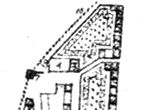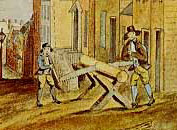Albany's Lutherans date their establishment as a church to 1649. However, records and verifiable resources for the earliest years are sparse and conflicting as the earliest Lutheran organizers chiefly were engaged in attempting to secure freedom to worship in New Netherland. After 1664, worship was less restrictive if only as the newcomers under the English represented more diverse religious traditions.
The Reverend Jacobus Fabritius came to New York and held what is said to be the first Lutheran service in Albany on April 25, 1669. His tenure was brief and he was followed by Reverend Bernard Arnzius in 1671. During the 1670s, the English solidified their hold on New York - thus providing Lutherans with more spiritual freedom.
 By 1680, the Albany Lutherans had purchased a house and two lots - the adjoining parcels to be used as a burial ground. The first church was built shortly thereafter on the south side of Albany, west of today's South Pearl Street, and just above the Ruttenkill as it meandered downhill on its way to the Hudson.
By 1680, the Albany Lutherans had purchased a house and two lots - the adjoining parcels to be used as a burial ground. The first church was built shortly thereafter on the south side of Albany, west of today's South Pearl Street, and just above the Ruttenkill as it meandered downhill on its way to the Hudson.
Sharing Pastor Arnzius with Lutherans in New York and along the Hudson, the Albany church was run more by its lay leaders who were called deacons.
As few of Albany's wealthier residents were members, the Albany Lutheran
church was unable to raise sufficient funds to support a resident
pastor. This problem became chronic and was not remedied until after
the Revolutionary War.
With the death of Bernard Arnzius in 1691, the Albany Lutheran church was without any pastor until May 1704 when Justus Falckner first arrived in Albany. However, Falckner's responsibilities were more than province-wide and prevented him from spending significant time in the upriver community. Over the past decade, the Albany congregation had dwindled as most of the pioneer elders had died and their children seem to have been drawn to the more mainstream Dutch Reformed church. At the same time, many of the more faithful Lutherans had spread out into the countryside of greater Albany County.
Although most years he made only an annual trip to Albany, Falckner sought to rebuild the Lutheran congregation at Albany. The earliest surviving records date from Falckner's time. He also ministered to Albany's Anglicans until the arrival of Reverend Thomas Barclay in 1708. Anglican services were held in the Lutheran church until St. Peter's English church was built several years later.
With Falckner's time shared with New York and Hackensack, the Albany congregation continued to decline. During the three decades of peace, newly arrived and established Lutherans continued to move to the more outlying regions with Loonenburg (today's Athens) becoming the Lutheran center of the upriver region.
Justus Falckner died in 1723. In 1731, Falckner was succeeded by Wilhelm Christoph Berkenmeyer who served in simultaneously in a number of locations until his death in October 1751. Berkenmeyer's chronicle of Lutheran activities in New York provide an important window on the Albany church and point up the Albany congregation's subordinate role in the development of Lutheran culture in the Hudson Valley. The church building had ceased to exist and the infrequent services were held in the home of leading Lutheran Jan Evertse and others.
In 1742, Philip Livingston,
the owner of an adjoining lot, enabled the
Albany Lutherans to build a "parish" or "church house" on the church
site. With no resident pastor, it was rented to deacon Evertse.
In the decades that followed, several itinerant pastors preached in Albany - although none of them actually lived in the city! Chief among them were Nicholas Sommer, Bavarian John W. S. Schwerdfeger, and John
C. Hartwick. Despite his loyalist sympathies, Schwerdfeger
served the Albany Lutherans during the Revolutionary war from his
home across the river in Brunswick. He later settled in Canada! 
In August 1784, the Albany Lutheran church was reorganized. Reverend Heinrich
Moeller served from 1784-90 and again in 1802-06. A new church was
built on the old site in 1786. In 1795, it was described as "of a
Gothic and very peculiar construction." Local lore tells us that stone
from the fort was used in its construction.
A list of the heads of its member families dated December 30, 1788 has been copied from a church history.
Christian Ehring, Heury Dowmann, Charles Newman, J. G. Hildebrand, John Or. Geyer, Wendel Hildebrand, Christopher Beekman, John Huth, for his wife, Matthew Kugler, John Jacobsen, John Ostrander, Evert Jansen, Martin Hebeysen, Philip Wagener, for his wife, Andreas Roller, Charles Bowmann, John Tillman, for his wife Mr. Erzberger, for his wife, Margaretta. Regina, John Hendrick Niemeyer, C. F. Diefenbach, George Klinck, Samuel Hendriok(Henderer?), Bernhard Bauer, John Zeilman, John Matthew Horn, Gerhard Mercelis, Michael Henn, Johannis Rattenaur, John Hood, Courad Freitag, Christian Benter, Andreas Benter, John Leonhard, Jorgen Benter, Nicholaus Michel, John Gross, John C. Fredeureich, Daniel Leonhard, John Arnhout, John Geyer, Omie LaGrange, Jacob Kummig. John C. Ruby. [43 member households]
During the 1600s and 1700s, Albany's Lutherans were chiefly of German or Scandinavian ancestry. Mostly, its members were middling representatives of the production and service economies and included an even larger number of regional farmers. Without a pastor for most of the colonial period, the Lutheran church served as a German cultural center in Albany. After the Revolutionary War, the church became more solidly established.

notes
Logo commemorating the Albany church's mission and history. The swan symbol for lutheranism has been reproduced widely. See the title of the standard history of the Albany church noted below.
Sources: The standard resource is Henry H. Heins, Swan of Albany: A History of the Oldest Congregation of the Lutheran Church in America Albany, 1976. Equally worthy (and more succinct) is the account of Albany's Lutherans appearing volume I of the Annals of Albany and reproduced online beginning on page 148. See also, one-time Albany cleric William B. Sprague's Annals of the American Pulpit: Lutheran . . . (volume 9, 1869), and then John O. Evjen, Scandinavian Immigrants in New York, 1630-1674, (Minneapolis, 1916). The published church Manual (1871) has been placed online. Baptism records from 1774-85; 1787, and afterwards are
available online thanks to Betty Fink! Her online transcriptions of printed records of the Gilead Lutheran Church in Brunswick include baptisms of some Albany Lutherans as well.
A translation and transcription of the deed is printed in Swan of Albany, 26-27. Elders named in the document were Myndert Frederickse (Van Iveren) and Albert Andriesse Bradt. Deacons identified were Anthony Lespenard and Carsten Frederickse (Van Iveren).
Detail from a map made by English chaplain John Miller
in 1695 showing the location of the Lutheran Church on the west side
of what became South Pearl Street.
The Albany Protocol: Wilhelm Christoph Berkenmeyer's Chronicle of Lutheran Affairs in New York Colony, 1731-1750, several translators but edited by John P. Dern (Ann Arbor, MI, 1971). This work is misnamed. Except for the introduction, it is more about the other Hudson Valley congregations. However, it documents his visits to Albany and generally represents an important resource!
Berkenmeyer observed in 1736 "The Albany congregation . . . had seen its pulpit thrown into the creek by a church vandal, and afterwards, without shedding a tear, had helped with its own hands to tear the church apart and gleefully haul off its old materials to their homes as plunder." Quoted in Swan of Albany, 44n.
We find existing accounts regarding the Livingston-Lutheran relationship puzzling! See Swan of Albany, pp. 44-45.
Home | Site Index | Email | New York State Museum
first posted 6/5/02; last updated 5/29/17